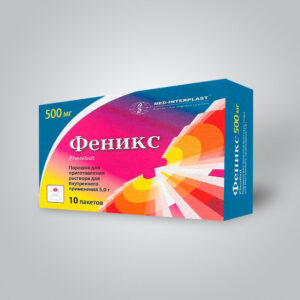 FENİKS 100 mg, 250 mg or 500 mg powder for oral solution
FENİKS 100 mg, 250 mg or 500 mg powder for oral solution
FENIKS
International non-patented name: Phenibut
Composition
Active ingredient: 1 package contains 500.0 mg, 250.0 mg or 100.0 mg of phenibut.
Excipients: aspartame (E 951), sugar.
Description
White or almost white powder.
Pharmacotherapeutic group
Other psychostimulants and nootropic drugs.
ATC code: N06BX22.
Pharmacological properties
Pharmacodynamics
Mechanism of action
The drug has nootropic and anxiolytic (tranquilizing) effects.
Pharmacodynamic effects
The active substance of the Fenix drug (γ-amino-β-phenyl fatty acid hydrochloride) can be considered as a derivative of γ-amino fatty acid (GAF) or a derivative of β-phenylethylamine. Phoenix drug has nootropic activity, and as a QAYT derivative, the drug exhibits an anxiolytic (tranquilizer) effect. The drug does not affect cholino- and adrenoreceptors. Anticonvulsant activity of Fenix drug is not observed. Fenix drug prolongs the latent (hidden) period of nystagmus, shortens its duration and weakens its intensity.
Pharmacokinetics
After oral administration, the drug is well absorbed and passes through the hematoencephalic barrier and penetrates into all tissues of the body. About 0.1% of the dose of the drug injected into the body penetrates into the tissues of the brain; in young and old patients, the ability of the drug to penetrate brain tissues is higher. 80-95% of the drug is metabolized in the liver, resulting in the formation of pharmacologically inactive metabolites. About 5% is excreted unchanged from the body through the kidneys. When repeated use, accumulation of the drug is not observed.
Instructions for use
The drug is used for high nervous alertness (neurasthenia) and sleep disorders.
In children – it is prescribed for the treatment of stuttering and tics.
Contraindications
Hypersensitivity to any of the components included in the composition of the preparation;
- pregnancy and lactation period;
- acute kidney failure;
- patients suffering from phenylketonuria (the drug contains aspartame);
- diabetes mellitus.
Special instructions and precautions
With long-term use, it is necessary to monitor peripheral blood parameters and liver functions.
Taking into account the irritating effect of the drug, precautions should be taken in patients with erosive-ulcer diseases of the gastrointestinal tract. These patients should be prescribed the drug in low doses.
If the symptoms of the disease persist during the use of the drug or if the patient’s condition worsens, it is necessary to consult a doctor.
The composition of the preparation includes aspartame. The use of aspartame is contraindicated in patients with phenylketonuria.
The drug contains sugar, and for this reason, patients with rare hereditary diseases such as fructose intolerance, glucose-galactose malabsorption or sucrase-isomaltase deficiency should not use the drug.
When prescribing the drug to patients suffering from diabetes, it should be taken into account that one dose of the drug contains the following amounts of sucrose: 2.86 g in 1 package of 100 mg, 2.71 g in 1 package of 250 mg, and 2.71 g in 500 mg In 1 package – 4.46 g.
When using the drug for 2 weeks or longer, the drug can cause damage to the teeth.
Interaction with other drugs
When using the Fenix drug in combination with other psychotropic drugs, it is required to consult a doctor beforehand and the treatment process should be carried out under the supervision of a doctor. Simultaneous use of Fenix with carbamazepine, oxcarbamazepine or MAO enzyme inhibitors is not recommended.
Incompatibility
Not applicable.
Use during pregnancy and lactation
Use of the drug during pregnancy and lactation is contraindicated.
Effects on the ability to drive a vehicle and other potentially dangerous mechanisms
Taking into account the possibility of developing disturbances in the central nervous system (tendency to sleep, dizziness), it is impossible to drive a vehicle or other potentially dangerous mechanisms during the use of the medicines.
Method of use and dosage
The contents of the package should be dissolved in half a glass of hot water and taken internally after meals. The prepared medicinal product should not be stored and should be used immediately after preparation.
The duration of the treatment course is determined individually by the doctor, taking into account the disease, tolerance to the drug and the obtained effect.
In case of high nervous alertness (neurasthenia) and sleep disorders – it is prescribed in a dose of 300-500 mg 3 times a day.
The maximum single dose of the drug is 750 mg.
The duration of the treatment course is 2-3 weeks. If necessary, the course of treatment can be extended up to 4-6 weeks.
Special patient groups
Children
Children from 3 to 8 years old – 2-3 times a day at a dose of 100 mg, children from 8 to 14 years old – at a dose of 200 mg 3 times a day.
In children over 14 years of age, the doses intended for adults are used.
Maximum single doses of the drug for children: 100 mg for children from 3 to 8 years old, 200 mg for children from 8 to 14 years old.
Use in elderly (over 65 years) patients
In patients over 60 years of age, the maximum single dose of the drug is 500 mg.
Patients with impaired liver and kidney function
The use of high doses of the Fenix drug in patients with impaired liver function may cause hepatotoxic effects. Patients in the indicated group should be prescribed relatively low doses of the drug, and at this time, liver functions should be monitored.
The use of the drug is contraindicated in patients with acute renal failure.
When the drug is used for a long time in patients with liver and/or kidney function disorders, monitoring of liver and kidney function indicators is required.
Side effects
Possible additional effects are described according to system organ classification and frequency of occurrence. The following classification was used to assess the frequency of occurrence of additional effects: very often (≥1/10), often (≥1/100, <1/10), sometimes (≥1/1000, <1/100) ), rarely (≥1/10,000, <1/1,000), very rarely (<1/10,000) or unknown (frequency cannot be estimated based on available data).
Disorders of the nervous system: unknown – drowsiness (at the beginning of treatment), increased irritability, alertness, excitability, headache, dizziness (when using in doses higher than 2 grams per day, the severity of the side effect decreases if the dose of the drug is reduced).
Gastrointestinal disorders: not known – nausea (at the beginning of treatment).
Disorders of the liver and biliary tract: not known – hepatotoxicity (when used in high doses for a long time).
Disorders of the skin and subcutaneous tissues: rarely – allergic reactions (rash on the skin, itching).
There have been reports of the development of emotional instability and sleep disorders in children after the use of the drug.
There are reports of tolerance (habituation) to the drug.
In case of additional reactions, including any additional reactions not mentioned in this leaflet, the use of the drug should be stopped and the patient should consult a doctor.
Overdose
There were no reports of overdoses.
In case of overdose, the following symptoms are likely to develop: drowsiness, nausea, vomiting, dizziness. When the drug is used in high doses (more than 7 grams) for a long time, eosinophilia, arterial hypotension, impaired kidney function, and fatty dystrophy of the liver may develop.
Treatment: gastric lavage, prescribing symptomatic treatment. The drug has no specific antidote.
Packing form
100 mg dosage: 3.0 g powder, in a package made of 4-layer K/PE/F/PE composite material.
250 mg dosage: 3.0 g powder in a 4-layer K/PE/F/PE composite package.
500 mg dosage: 5.0 g powder in a 4-layer K/PE/F/PE (paper/polyethylene/foil/polyethylene) composite package.
10 packets are packed in a cardboard box with an insert.
Store condition
It should be stored at a temperature not higher than 25°C, protected from moisture and light and out of the reach of children.
Special precautions for disposal of used medicinal product or medicinal product residues after use or handling
There are no special requirements.
Shelf life
2 years.
By prescription.
Manufacturer
“Med-interplast” foreign unitary production enterprise, Belarus.
222603, Minsk region, Nesvizh city, Leninskaya str., 115, room 204
